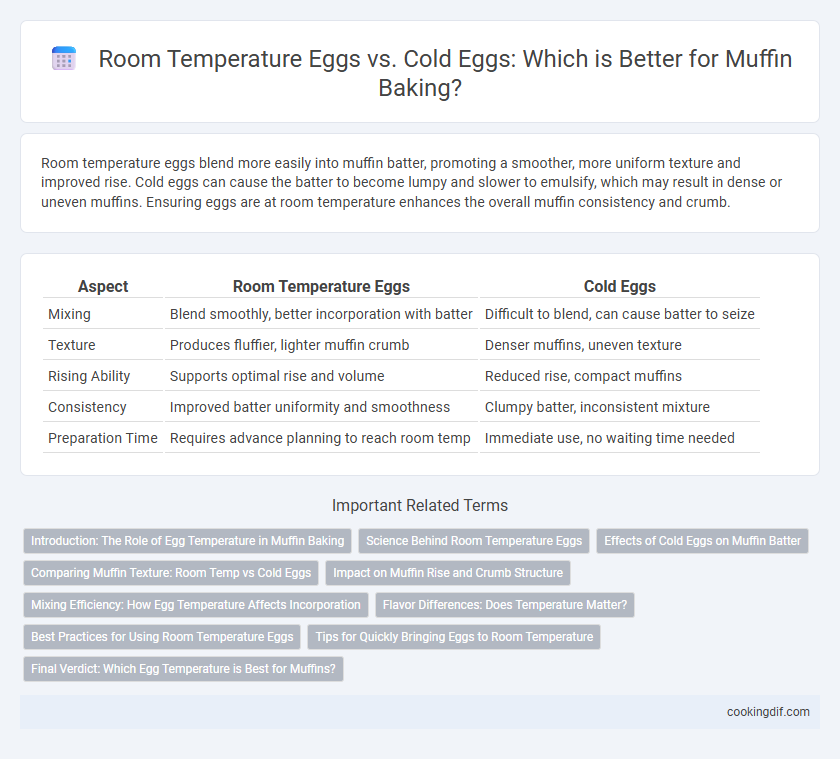Room temperature eggs blend more easily into muffin batter, promoting a smoother, more uniform texture and improved rise. Cold eggs can cause the batter to become lumpy and slower to emulsify, which may result in dense or uneven muffins. Ensuring eggs are at room temperature enhances the overall muffin consistency and crumb.
Table of Comparison
| Aspect | Room Temperature Eggs | Cold Eggs |
|---|---|---|
| Mixing | Blend smoothly, better incorporation with batter | Difficult to blend, can cause batter to seize |
| Texture | Produces fluffier, lighter muffin crumb | Denser muffins, uneven texture |
| Rising Ability | Supports optimal rise and volume | Reduced rise, compact muffins |
| Consistency | Improved batter uniformity and smoothness | Clumpy batter, inconsistent mixture |
| Preparation Time | Requires advance planning to reach room temp | Immediate use, no waiting time needed |
Introduction: The Role of Egg Temperature in Muffin Baking
Egg temperature significantly impacts the texture and rise of muffins, with room temperature eggs blending more smoothly into batter for even aeration. Cold eggs can cause uneven mixing, resulting in denser muffins with less volume. Bakers often prefer room temperature eggs to enhance gluten development and achieve a lighter, more tender crumb.
Science Behind Room Temperature Eggs
Room temperature eggs incorporate more effectively in baking because their proteins and fats blend seamlessly with other ingredients, resulting in a smoother batter and better rise. Cold eggs can cause batter to curdle or produce uneven textures due to the temperature difference slowing emulsification. Scientific studies show that warming eggs to room temperature promotes optimal interaction between lecithin and fats, enhancing the structural integrity of cakes and muffins.
Effects of Cold Eggs on Muffin Batter
Cold eggs can slow down the emulsification process in muffin batter, leading to uneven mixing and potential pockets of flour. Incorporating cold eggs often results in denser muffins with a coarser crumb structure due to reduced batter aeration. Room temperature eggs promote better integration, enhancing the rise and texture of the final baked muffins.
Comparing Muffin Texture: Room Temp vs Cold Eggs
Room temperature eggs blend more smoothly into muffin batter, promoting even moisture distribution and resulting in a tender, uniform crumb. Cold eggs can cause the batter to seize or mix unevenly, leading to denser muffins with inconsistent texture. Bakers often prefer room temperature eggs to enhance muffin rise and achieve a soft, airy interior.
Impact on Muffin Rise and Crumb Structure
Room temperature eggs blend more evenly into muffin batter, promoting better emulsification and resulting in a superior rise and finer crumb structure. Cold eggs can cause uneven mixing, leading to denser muffins with irregular air pockets. Optimizing egg temperature at room level enhances the leavening process and creates a tender, uniform crumb texture.
Mixing Efficiency: How Egg Temperature Affects Incorporation
Room temperature eggs mix more efficiently into muffin batter due to their lower viscosity, allowing them to blend seamlessly with other ingredients and create a smoother, more homogeneous mixture. Cold eggs can cause uneven mixing, resulting in lumps or incomplete integration that affects muffin texture. Efficient incorporation of room temperature eggs leads to better volume and crumb structure in the final baked product.
Flavor Differences: Does Temperature Matter?
Room temperature eggs incorporate more evenly into muffin batter, enhancing the texture and allowing flavors to meld seamlessly for a richer taste. Cold eggs can cause uneven mixing, potentially resulting in pockets of thicker batter and muted flavor profiles. Maintaining eggs at room temperature ensures optimal flavor development and consistent crumb in muffins.
Best Practices for Using Room Temperature Eggs
Room temperature eggs blend more uniformly into muffin batter, promoting better aeration and consistent texture compared to cold eggs. Using eggs at room temperature helps achieve optimal volume and tenderness by allowing ingredients to emulsify effectively. For best results, set eggs out 30 minutes before mixing to enhance muffin rise and crumb quality.
Tips for Quickly Bringing Eggs to Room Temperature
Cold eggs can cause batter to curdle or mix unevenly, making room temperature eggs essential for smooth incorporation in baking. To quickly bring eggs to room temperature, place them in a bowl of warm water (around 100degF or 38degC) for 5 to 10 minutes, which softens the yolks for better emulsification. Another effective method is to crack eggs into a bowl and whisk gently, allowing them to reach room temperature faster and integrate seamlessly into muffin batter.
Final Verdict: Which Egg Temperature is Best for Muffins?
Room temperature eggs blend more smoothly into muffin batter, promoting even texture and optimal rise during baking. Cold eggs can cause uneven mixing, leading to denser muffins with inconsistent crumb. For the best muffin results, using room temperature eggs ensures a tender, moist, and well-risen final product.
Room temperature eggs vs Cold eggs for incorporation Infographic

 cookingdif.com
cookingdif.com